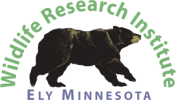foot pads and fecal plugs - UPDATE February 8, 2010
February 8, 2010 - 8:00 PM CST
More on misconceptions. We often hear that bears hibernate for 5-7 months without eating, drinking, urinating, and defecating. Some may do that, but the statement is a simplification.
It’s true most don’t eat. In northeastern Minnesota, there’s nothing to eat except the pads of their feet. In mid to late winter, they shed their calloused old pads and sometimes ingest them. From that comes the Native American legend that bears crush berries into their foot pads all summer as they cruise their ranges, and then survive overwinter by sucking the essence of berries out of the pads, even consuming the pads themselves. We do find pieces of foot pads in fecal plugs near dens, so who can say the legend is wrong?
What is a fecal plug? Another legend written in supposedly scholarly books states that just before hibernation, bears eat roughage to make a fecal plug to prevent further feeding. A fecal plug does form in the colon, but it’s at the wrong end to prevent feeding. The fecal plug is nothing mysterious. Just like starving people, bears continue to make feces even though they are not eating. Where does the fecal plug come from? Intestinal cells slough off during winter and accumulate as feces. Roughage in the feces matches the bedding in the den and includes some hair. They undoubtedly ingest some bedding accidentally as they rearrange it, as you have seen, or as they rake it into the den in fall (or in winter as we saw Lily bring in branches and bite them into smaller pieces for bedding). They also groom in the den which would account for hair in the fecal plug.
As far as drinking goes, there is no water available in the frozen north, but some bears eat snow. Fat metabolism also provides water, and metabolic water may be enough for some bears. Just about everything a person might say about a bear falls under a bell shaped curve. Most bears would fall in the middle of the curve, but some are out in each tail. So there are exceptions to much of what a person might say.
Do they urinate in winter? Probably most do not, according to captive studies, and that topic leads into more wonders of hibernation for another update.
Thank you again for the donations. Many of you have donated and it’s much appreciated. Every penny will go for debt reduction, which, in turn, will enhance our mission.
—Lynn Rogers and Sue Mansfield, Biologists, North American Bear Center
